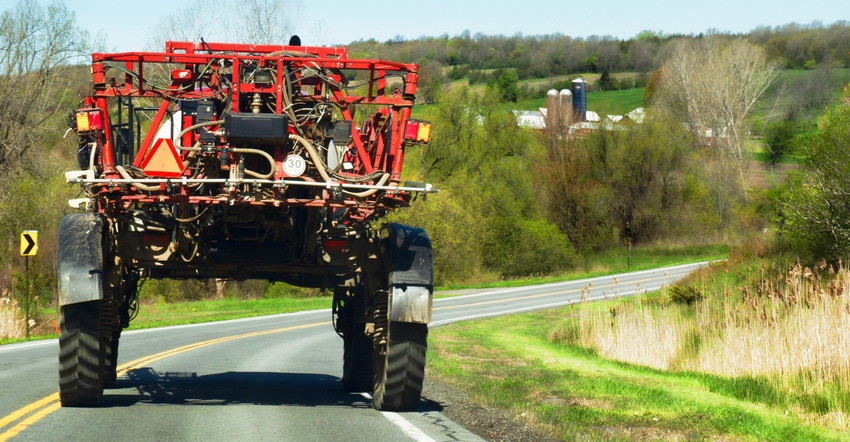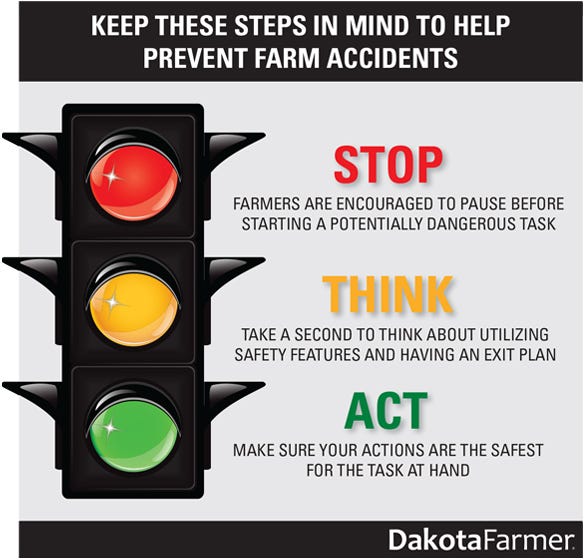
The agriculture industry has high rates of fatalities and serious injuries, and ranks as one of the most dangerous professions in the United States, according to the USDA.
Angie Johnson, North Dakota State University Extension agent and NDSU Extension farm and ranch safety coordinator, says that most on-farm injuries can be prevented if by slowing down and shifting focus from “I need to get the job done at all costs�” to “I need to get the job done safely so I can go home each night to my loved ones and continue my passion of farming.”
“It can seem so trivial and simple, but getting enough sleep and rest is huge,” Johnson says. “The more fatigue you’re experiencing, the more your reaction time slows down.” This is especially true during calving, planting and harvest seasons when the work hours are long with a high demanding physical and mental workload.
For producers transporting large equipment along roadways, some steps can be taken to decrease the risk of tragedy. “You’ve got to have your hazard lights on and use turn signals so people can visibly see you, especially at night because that’s when equipment gets tough to see,” she explains. Adding additional safety lights, and tying transportation flags on equipment are other ways to stay visible when traveling with equipment.
For both producers and other vehicles driving, just follow the rules of the road. “If you’re meeting a large piece of equipment and there’s an ability to pull onto a safe approach, give yourself enough room to be out of the way and allow that machinery to pass by,” she says. “Equipment drivers need to be sure that we are really staying in our lanes, watching our rearview and side mirrors, and being cautious, looking out for road signs, mailboxes, overhead power lines and power poles.”
Use safety features
“Be intentional of what you’re doing,” Johnson advises. She says producers should stop, think and then act for on-the-job problems. “Let’s say the belt on a round baler has twisted, so I need to go inside the baler and get the belt untwisted. First, I need to shut the PTO off; then let it cool down before I start working on it. On a baler, there is a safety feature that allows you to lock that chamber door open so that it can’t fall shut and close on you. Hitting that switch when you start working on it is key, and that’s exactly when you need to stop, think and act.”
Doing things in a hurry when trying to beat Mother Nature can make things go sideways on the farm.. “The chain might’ve jumped off, but did you shut the PTO off or did you release the hydraulic arm before you went to put the chain back on? It’s those quick, indecisive decisions that are when we start seeing accidents,” Johnson explains.

Stutsman County in North Dakota has experienced two grain bin-related deaths in a three-month period. “It’s just devastating,” Johnson recalls. “We have to really focus on our ROI and how much that grain in the bin is really worth. We have great work ethic here in the Midwest; we don’t quit until the job is done. But we can shift our mindset as to how we get that job done safely.”
NDSU Extension and Johnson are working to equip producers with a safety mindset, and the knowledge to mitigate risk whenever possible. “Think about this: Every time we get in a car to drive, we’re taking a risk, and one of the things we do to mitigate that risk is buckling our seat belt,” she says. “Conducting tasks on the farm should be no different. Think ahead on what you need to do to mitigate that risk, and if you have employees on your farm, mitigating risk can be as simple as taking time to properly coach them on operating your equipment.”
Mitigate risk around livestock
Livestock injuries are also prevalent, when animals have a mind of their own and aren’t as predictable as machinery.
This calving season in the Red River Valley, a rancher had his back broken by a cow who charged when he was doctoring a calf. Injuries like this can be prevented by planning for the worst and knowing your herd.
“If you know you have a mean cow in your barn or in your calving shed, think about your exit strategy going in. Maybe there’s another pen you can climb over to get away, or an access point to get out of her way,” Johnson says.
At her family farm, Johnson says that with some animals, additional planning keeps her and her family safe. “We have a couple cows that see some behavior changes after they calf, as the birthing process involves so many hormonal changes in the animal. We have to remember they are animals, and their instinct is to protect that newborn at all costs.
“We make a plan and talk it out ahead of time of how we’re going to swing this gate over from this pen, and not even have to go inside the pen with her and then we are safely out of her way. We don’t execute our plan until we all understand where we need to be and what our role is. If the animal continues to pose a danger to us or even other cattle around, we start make culling decisions based on the animal’s temperament as well.”
For safety, adapting barns might be needed, as well as implementing culling decisions based on temperament.
NDSU Extension and University of Minnesota Extension collaborated on a series of farm safety webinars this spring. Those webinars and more farm safety information can be found on NDSU’s Farm Safety webpage.
About the Author(s)
You May Also Like






